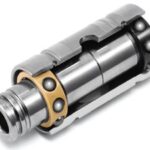The P0325 diagnostic trouble code (DTC) indicates a problem with the knock sensor (KS) circuit in your vehicle. This sensor plays a crucial role in engine performance and fuel efficiency by detecting engine knocking and allowing the Engine Control Module (ECM) to adjust ignition timing accordingly. Understanding this code is essential for proper diagnosis and repair.
What is a Knock Sensor and How Does it Work?
A knock sensor is a small piezoelectric device mounted on the engine block. It detects vibrations caused by engine knocking, also known as detonation. These vibrations generate a voltage signal proportional to the intensity of the knocking. The ECM receives this signal and adjusts the ignition timing to prevent damaging detonation. The P0325 code signifies that the ECM has detected an abnormal voltage signal from the knock sensor circuit.
Symptoms of a P0325 Code
While the check engine light may not illuminate for a P0325 code in some vehicles, you might experience:
- Decreased fuel economy: The engine may run less efficiently due to improper ignition timing.
- Loss of power: Engine performance can be negatively impacted by persistent knocking.
- Engine pinging or knocking: Audible knocking sounds, especially under load or acceleration, indicate a potential problem.
Causes of a P0325 Code
Several issues can trigger a P0325 code:
- Faulty Knock Sensor: A damaged or malfunctioning knock sensor can send incorrect voltage signals to the ECM.
- Wiring Problems: Damaged, corroded, or loose wiring in the knock sensor circuit can disrupt signal transmission. This includes open circuits, shorts to ground, or shorts to power.
- Loose or Damaged Connector: A poor connection at the knock sensor or ECM connector can cause signal interruption.
- ECM Malfunction: Although less common, a faulty ECM can misinterpret signals or fail to communicate correctly with the knock sensor.
Diagnosing a P0325 Code
Diagnosing a P0325 code involves a systematic approach:
-
Visual Inspection: Begin by inspecting the knock sensor wiring harness and connectors for visible damage, looseness, or corrosion.
-
Check Ground Connections: Ensure engine ground screws are properly tightened. Loose ground connections can disrupt circuit functionality. Engine Ground Location
-
Signal Circuit Continuity Test: Use a multimeter to check for continuity between the knock sensor and the ECM. This verifies that the signal pathway is intact. Knock Sensor and ECM Connector Locations
-
Knock Sensor Resistance Test: Measure the resistance of the knock sensor using an ohmmeter. Compare the reading to the manufacturer’s specifications to determine if the sensor is within the acceptable range. Knock Sensor Resistance Testing
-
Shield Circuit Continuity Test: Verify the continuity of the knock sensor shield circuit to ground. This protects the signal from electromagnetic interference.
-
Intermittent Fault Diagnosis: If the problem is intermittent, specialized diagnostic equipment may be required to pinpoint the cause.
Fixing a P0325 Code
Based on the diagnosis, common solutions for a P0325 code include:
- Replace the Knock Sensor: If the sensor is faulty, replacement is usually necessary. Handle new knock sensors with care as they can be sensitive to damage from dropping or impact.
- Repair Wiring or Connectors: Repair or replace any damaged, corroded, or loose wiring and connectors.
- Tighten Ground Connections: Ensure all engine ground connections are secure.
- Address ECM Issues: If the ECM is malfunctioning, it may require reprogramming or replacement. This is a more complex repair best left to a qualified technician.
Conclusion
The P0325 knock sensor code indicates a potential issue that can impact engine performance and fuel efficiency. By following a systematic diagnostic approach, you can pinpoint the cause of the problem and implement the appropriate solution. While some repairs can be done by DIYers, more complex issues may require the expertise of a qualified mechanic. Addressing this code promptly will help ensure optimal engine operation and prevent potential damage.


